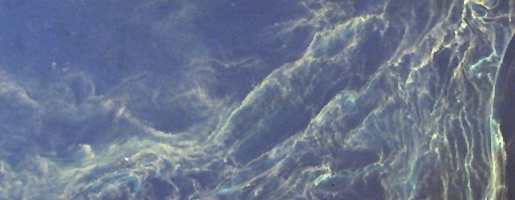 |
|||
|
A
plankton bloom 200 kilometres across in the Pacific Ocean.
|
|||
| LIFE ON EARTH | |||
| Earth is home to many millions of recorded species of lifeforms. Examination reveals them all to be made from the most abundant elements in the universe : hydrogen, oxygen, carbon and nitrogen. If life has thrived on Earth, is it possible that it may have at least got started elsewhere in the Solar System? | |||
| Signs of Life | |||
| The Galileo space probe detected methane and nitrous oxide in Earth's atmosphere when it flew by on the way to Jupiter. Both these gases are products of biological activity. Less direct evidence is provided by the abundance of oxygen in the atmosphere, which cannot be explained by chemical processes alone - it is the result of the photosynthesis of plant life. Earth is also very wet, with liquid water providing an ideal medium in which organic molecules can interact in solution. | |||
| Inspection of the surface shows that vegetation covers much of the land. Life has even altered the chemical composition of Earth's rocks : carbonate sedimentary rocks and coral reefs are due to animal life in the sea. Over 3,000 million years, life on Earth has evolved to the level of the higher animals, including intelligent life - mankind, whose agricultural and construction patterns can be seen across large areas. | |||
 An infrared image (left) of the Earth from the Galileo space probe. |
 A "vegetation index" image (right) of the Earth showing chlorophyll in growing plants. |
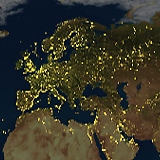 Images taken at night show cities and industrial activity. |
|
 A carpet of green vegetation flanks the River Nile. |
 Fields, roads and an airport runway at the edge of an urban area. |
||
| Origins of Life | |||
| Life requires chemical compounds complex enough to record the genetic codes which govern reproduction and inheritance. A potential lifeform cannot propagate without these blueprints. Life as we know it uses clumps of organic (carbon-based) compounds - proteins - to record its genetic codes. Proteins are themselves are made up of long chains of amino acids, containing nitrogen. Liquid water is also a key ingredient in the development of life, acting as the medium in which organic compounds can interact in solution. | |||
| The origins of life are uncertain. Organic compounds are found in asteroids and comets, suggesting that life on Earth may have originated in outer space. It is unlikely, however, that organic material was brought to Earth in sufficient quantities to produce life. More likely, chemical reactions in the gases in Earth's early atmosphere or those expelled at deep-sea volcanic vents, produced simple organic compounds. Further reactions built up more complex molecules which became the building blocks of the first lifeforms: primitive bacteria. | |||
| Amino acids have been produced in the laboratory from mixtures of gases representing the early atmosphere, with the necessary chemical reactions triggered by electrical sparks - a substitute for lightning. Ultraviolet radiation - much more intense in the early atmosphere before the development of the ozone layer - could also have provided the energy to trigger these reactions. Under this scenario, the ocean surface would have become a soup of organic matter, from which the first biological cell would have evolved. | |||
| Recent discoveries of lifeforms in a range of very hostile environments - extremophiles - have drawn attention to places other than the ocean surface as the possible original home of life. Bacteria have been found living in hot springs at 80-90oC, at volcanic vents on the seafloor and even at depths of more than 4,000 metres in solid rock. Volcanic vents, or fumeroles, on the deep ocean floor support a diverse range of lifeforms which do not rely on energy from the sun, and have become a particular focus for research. The basis of the food chain in this environment is a bacterium that consumes the carbon dioxide and hydrogen sulphide erupted from the fumeroles. The fumerole bacteria are fed on by white tube worms over a metre long and 30 centimetre-wide clams. | |||
| Volcanism is common elsewhere in the Solar System, so the conditions which may have given birth to life on Earth may not be unique. Liquid water was present on the surface of Mars at the same time as volcanic activity more than 3,000 million years ago. A liquid water ocean may underlie Europa's icy surface today and this possibility has made that moon a major target for exploration. | |||
| Evolution | |||
| The evolution of life on Earth may be followed in the record of fossils preserved in the sedimentary rocks of the crust. The first fossils of primitive cells are found in stromatolite formations 3,500 million years old - relatively early in Earth's history. Well-organised algae are found about 2,000 million years ago (mya). Algae were the first plants, converting carbon dioxide and water into food in the presence of sunlight in the surface layers of the ocean. | |||
| This process of photosynthesis started to change the chemical composition of the atmosphere, removing carbon dioxide and replacing it with oxygen. Organisms soon evolved to take advantage of the newly-available oxygen: simple bacteria which gained energy through respiration, the reverse of photosynthesis. Respiration is the mechanism all animals rely on, burning carbohydrates with oxygen to release the energy originally stored by plants. | |||
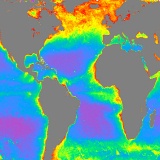 Earth's ocean surface has long been home to photosynthesising plankton, shown here by their chlorophyll content. |
|||
| The first cell with a nucleus appeared around 1,000 million years ago and the stage was set for the explosion of higher forms of life which gave us the plant and animal kingdoms. The first shelled animals are found in the fossil record 570 million years ago. By 500 million years ago, the first vertebrates had arrived in the form of fish. Around 400 million years ago, life spread out of the sea as the higher plants colonised the land surface. | |||
| They had it to themselves until the arrival of the first reptiles, 250 million years ago. Evolution is driven by environmental changes, and the fossil record is punctuated by mass extinctions of many species. Some of these can be attributed to geological events such as the growth or break-up of a continent, climate change or the impact of a comet or asteroid. New circumstances give a chance for new evolutionary lines to develop and thrive. | |||
| Life and the Planet | |||
| Respiration produces carbon dioxide, but the early respiring bacteria were outpaced by the carbon dioxide-consuming algae, so atmospheric carbon dioxide levels fell and oxygen levels increased. High oxygen levels allowed the rapid development of higher forms of respiring life - the animals, protected from harmful ultraviolet radiation by a layer of ozone in the upper atmosphere. | |||
| The first shelled animals made possible a new type of rock: carbonate sedimentary rocks, built up from the dead animals shells when they sank to the seabed, and reef structures where coral colonies grew. The dense swampy vegetation which followed the plants' colonisation of the land also made possible a new biological sediment - coal. | |||
 A coral reef island in the South China Sea. |
|||
| Intelligent Life | |||
| No single species has had more effect on the surface of the planet than mankind. Man-like creatures first appeared a few million years ago. Homo sapiens evolved within the last million years. The biggest challenge to the new species was offered by the ice age which started about 100,000 years ago. Humans, who had cooperated in social groups as hunter-gatherers, learned to take advantage of natural shelter such as caves and then to build their own shelters. Towards the end of the ice age, 11,000 years ago, the development of organised agriculture allowed the founding of fixed settlements. Agricultural surpluses allowed the growth of large cities, which became the focus of trade, learning and artistic expression. Mankind now has the ability to engineer a comfortable environment anywhere on the surface of the Earth and, indeed, for limited journeys into space. | |||
 Agricultural fields have replaced natural vegetation cover across much of Earth's surface. |
 Cairo, one of the fastest-growing cities on Earth, sited on the edge of a fertile river delta. |
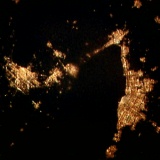 The cities of Toronto, Canada, and Buffalo, New York, shine out at night. |
|
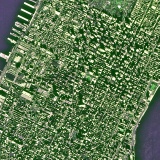 New York City represents the artificial urban habitat created by mankind. |
|||
| Humanity's activities have had large-scale effects on the Earth's landscape. Most of Europe's natural forest cover was cleared for agriculture by 1,000 years ago. Today, irrigation schemes support well-ordered fields of crops in the middle of deserts. Some large bodies of water, such as the Aral Sea, have become much depleted as a result. Large parts of the tropical rainforests are being cleared for timber or to make room for agriculture, resulting in the loss of habitat and possible extinction of many species in this biologically diverse ecosystem. | |||
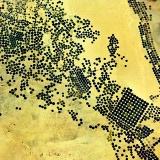 Centre-pivot irrigation systems produce circular fields in the Nafud Desert. |
 Logging patterns in the forest of western Canada. |
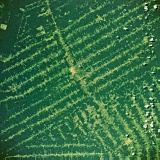 Forest clearance in South America follows roads driven straight into the jungle. |
|
| Human activities are even changing the composition of the atmosphere. The burning of fossil fuels in the industrial age - coal, oil and gas - is raising levels of carbon dioxide, which could lead to climate change through an enhanced greenhouse effect. Long-lived industrial gases have led to a thinning of the protective ozone layer, exposing lifeforms to increased levels of ultraviolet radiation. | |||
| The pace of environmental change on the planet may be greater than at any time since the last ice age. It remains to be seen how life on Earth will react to these changes. | |||
|
|
|||